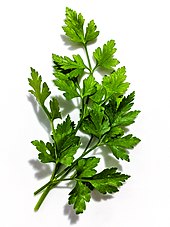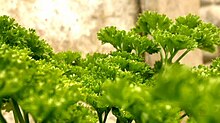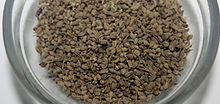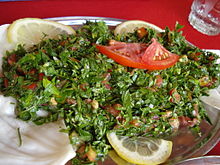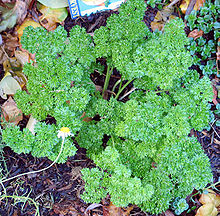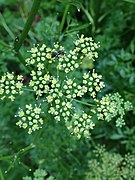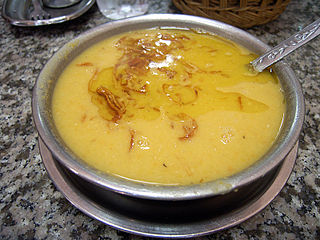Contents
- Etymology
- Description
- Uses
- Culinary
- Composition
- Nutritional content
- Precautions
- Cultivation
- Cultivars
- Gallery
- See also
- References
- External links
| Parsley | |
|---|---|
 | |
| Parsley leaves and flowers | |
| Scientific classification | |
| Kingdom: | Plantae |
| Clade: | Tracheophytes |
| Clade: | Angiosperms |
| Clade: | Eudicots |
| Clade: | Asterids |
| Order: | Apiales |
| Family: | Apiaceae |
| Genus: | Petroselinum |
| Species: | P. crispum |
| Binomial name | |
| Petroselinum crispum | |
| Synonyms [1] | |
List
| |
Parsley, or garden parsley ( Petroselinum crispum) is a species of flowering plant in the family Apiaceae that is native to Greece, Morocco and the former Yugoslavia. [1] It has been introduced and naturalized in Europe and elsewhere in the world with suitable climates, and is widely cultivated as a herb, and a vegetable.
It is believed to have been originally grown in Sardinia and was cultivated in around the 3rd century BC. Linnaeus stated its wild habitat to be Sardinia, whence it was brought to England and apparently first cultivated in Britain in 1548,[ citation needed ] though literary evidence suggests parsley was used in England in the Middle Ages, as early as the Anglo-Saxon period. [2]
Parsley is widely used in European, Middle Eastern, and American cuisine. Curly-leaf parsley is often used as a garnish. In central Europe, eastern Europe, and southern Europe, as well as in western Asia, many dishes are served with fresh green chopped parsley sprinkled on top. Flat-leaf parsley is similar, but is often preferred by chefs because it has a stronger flavor. [3] Root parsley is very common in central, eastern, and southern European cuisines, where it is used as a snack or a vegetable in many soups, stews, and casseroles.
